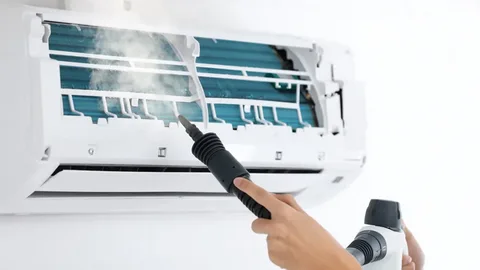Duct AC Systems: Benefits, Types, and Maintenance Tips
Duct AC Systems: Benefits, Types, and Maintenance Tips

on
As temperatures rise, having an efficient cooling system becomes crucial, especially in hot climates. Duct AC systems, also known as central air conditioning systems, have become a popular choice for many homeowners and businesses. These systems provide consistent cooling and improve indoor air quality. In this blog, we’ll explore the ins and outs of duct AC systems, including their benefits, types, maintenance tips, and how to choose the right system for your needs.
What is a Duct AC System?
A duct AC system consists of a central unit that cools the air and a network of ducts that distribute this conditioned air throughout your home or building. This system uses a thermostat to maintain a consistent temperature, providing comfort during hot weather.
How Does It Work?
The process begins when the thermostat signals the AC unit to turn on. The unit pulls in warm air from the indoor space, cools it using refrigerant, and then pushes the cooled air through the ducts into various rooms. This circulation keeps your space uniformly cool and comfortable.
Benefits of Duct AC Systems
Duct AC systems offer numerous advantages. Here are some compelling reasons to consider installing one:
1. Efficient Cooling
Duct AC systems efficiently cool large spaces, ensuring consistent temperatures throughout. Unlike window units or portable air conditioners, ducted systems distribute air evenly, eliminating hot spots.
2. Improved Indoor Air Quality
These systems filter air as it circulates, trapping dust, allergens, and other pollutants. Regular maintenance, such as changing filters, can enhance air quality, making your home healthier.
3. Quiet Operation
Duct AC systems operate quietly compared to window units. Since the central unit is often located outside or in a separate space, you enjoy peace and quiet indoors while still benefiting from effective cooling.
4. Aesthetic Appeal
With ducted systems, you avoid unsightly window units or portable air conditioners. Ducts are hidden within walls or ceilings, maintaining the visual appeal of your home or office.
5. Versatile Zoning Options
Many duct AC systems offer zoning capabilities, allowing you to control temperatures in different areas of your home independently. This feature enhances comfort and saves energy by cooling only the spaces in use.
Types of Duct AC Systems
When considering a duct AC system, it’s essential to understand the different types available. Here’s an overview of the most common options:
1. Split-System Air Conditioners
A split-system air conditioner consists of two main components: an outdoor unit that houses the compressor and an indoor unit that contains the evaporator coil. This type of system works well for both residential and commercial spaces.
2. Packaged Air Conditioners
Packaged systems combine the evaporator, condenser, and compressor into a single unit, typically placed on the roof or beside the building. This type is ideal for limited space and works well in commercial settings.
3. Ductless Mini-Split Systems
Ductless mini-split systems provide a flexible alternative for cooling individual rooms or areas without extensive ductwork. They consist of an outdoor compressor unit and one or more indoor air handlers.
Installation of Duct AC Systems
Installing a duct AC system involves several critical steps. Here’s a brief overview of the installation process:
1. Consultation and Assessment
Start with a consultation from a qualified HVAC technician. They will assess your space, discuss your cooling needs, and recommend the best system for your home or business.
2. Design and Planning
Once you choose a system, the technician will design the ductwork layout. This plan ensures optimal airflow and efficiency throughout your space.
3. Ductwork Installation
The next step involves installing the ductwork. This process requires careful measurements and cutting to ensure proper fit and function.
4. Unit Installation
After the ducts are in place, the technician will install the outdoor and indoor units, connecting them to the ductwork.
5. System Testing
Once everything is installed, the technician will conduct tests to ensure the system operates correctly. They will check for leaks, airflow, and overall performance.
Maintenance Tips for Duct AC Systems
To keep your duct AC system running efficiently and prolong its lifespan, follow these maintenance tips:
1. Regular Filter Changes
Changing or cleaning your air filters every 1 to 3 months is essential. Dirty filters restrict airflow, making your system work harder and increasing energy bills.
2. Schedule Professional Inspections
Plan for regular professional inspections and maintenance at least once a year. Technicians can identify potential issues early and ensure your system operates efficiently.
3. Keep Ducts Clean
Over time, dust and debris accumulate in your ductwork. Schedule professional duct cleaning every few years to improve air quality and system efficiency.
4. Monitor Thermostat Settings
Ensure your thermostat functions correctly and accurately reflects your desired temperature. Consider upgrading to a programmable thermostat for better energy management.
5. Seal Duct Leaks
Check for leaks in your ductwork. Leaks can waste energy and reduce efficiency. If you notice any gaps, consult a professional to seal them.
Choosing the Right Duct AC System
Selecting the right duct AC system for your home or business involves several considerations:
1. Assess Your Space
Evaluate the size of the area you need to cool. A professional can perform a load calculation to determine the appropriate capacity (measured in BTUs) for your system.
2. Consider Energy Efficiency
Look for systems with a high SEER (Seasonal Energy Efficiency Ratio) rating. Higher ratings indicate more efficient systems, leading to lower energy costs.
3. Budget
Set a budget for your AC system and installation. While initial costs are essential, consider long-term savings on energy bills and maintenance when making your decision.
4. Research Brands and Models
Different brands offer various features and warranties. Research and compare models to find the one that best suits your needs and preferences.
5. Consult Professionals
Always consult with HVAC professionals to gain insights into the best options for your specific situation. Their expertise will guide you toward making an informed choice.
Common Issues with Duct AC Systems
Understanding common issues can help you identify problems early and seek prompt repairs. Here are a few common problems:
1. Insufficient Cooling
If certain rooms feel warmer than others, this may indicate a problem with your ductwork or an issue with the thermostat. A technician can assess and rectify the situation.
2. Unusual Noises
Strange sounds, such as banging, rattling, or hissing, can signal mechanical issues or loose components. If you hear unusual noises, contact a professional immediately.
3. Increased Energy Bills
A sudden spike in energy costs may indicate that your system is working harder than necessary. Schedule an inspection to identify and resolve any underlying issues.
4. Poor Air Quality
If you notice increased dust or allergens in your home, it may result from dirty ducts or malfunctioning filters. Cleaning your ducts and changing filters regularly can help.
Conclusion
Duct AC systems offer efficient cooling, improved indoor air quality, and aesthetic appeal. Understanding their benefits, types, installation process, and maintenance tips will empower you to make informed decisions for your home or business. Investing in a quality duct AC system ensures comfort, convenience, and cost savings in the long run.
See more:
https://www.florevit.com/read-blog/3808_ac-ducts-explained-importance-types-and-maintenance-tips.html



